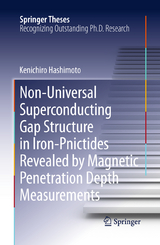Non-Universal Superconducting Gap Structure in Iron-Pnictides Revealed by Magnetic Penetration Depth Measurements
Seiten
This book shows that superconducting gap structure in iron-based superconductors depends on detailed electronic structure via magnetic penetration depth measurements, and that gap structure in iron-pnictides can be interpreted in the framework of A1g symmetry.
In this book the author presents two important findings revealed by high-precision magnetic penetration depth measurements in iron-based superconductors which exhibit high-transition temperature superconductivity up to 55 K: one is the fact that the superconducting gap structure in iron-based superconductors depends on a detailed electronic structure of individual materials, and the other is the first strong evidence for the presence of a quantum critical point (QCP) beneath the superconducting dome of iron-based superconductors.
The magnetic penetration depth is a powerful probe to elucidate the superconducting gap structure which is intimately related to the pairing mechanism of superconductivity. The author discusses the possible gap structure of individual iron-based superconductors by comparing the gap structure obtained from the penetration depth measurements with theoretical predictions, indicating that the non-universal superconducting gap structure in iron-pnictides can be interpreted in the framework of A1g symmetry. This result imposes a strong constraint on the pairing mechanism of iron-based superconductors.
The author also shows clear evidence for the quantum criticality inside the superconducting dome from the absolute zero-temperature penetration depth measurements as a function of chemical composition. A sharp peak of the penetration depth at a certain composition demonstrates pronounced quantum fluctuations associated with the QCP, which separates two distinct superconducting phases. This gives the first convincing signature of a second-order quantum phase transition deep inside the superconducting dome, whichmay address a key question on the general phase diagram of unconventional superconductivity in the vicinity of a QCP.
In this book the author presents two important findings revealed by high-precision magnetic penetration depth measurements in iron-based superconductors which exhibit high-transition temperature superconductivity up to 55 K: one is the fact that the superconducting gap structure in iron-based superconductors depends on a detailed electronic structure of individual materials, and the other is the first strong evidence for the presence of a quantum critical point (QCP) beneath the superconducting dome of iron-based superconductors.
The magnetic penetration depth is a powerful probe to elucidate the superconducting gap structure which is intimately related to the pairing mechanism of superconductivity. The author discusses the possible gap structure of individual iron-based superconductors by comparing the gap structure obtained from the penetration depth measurements with theoretical predictions, indicating that the non-universal superconducting gap structure in iron-pnictides can be interpreted in the framework of A1g symmetry. This result imposes a strong constraint on the pairing mechanism of iron-based superconductors.
The author also shows clear evidence for the quantum criticality inside the superconducting dome from the absolute zero-temperature penetration depth measurements as a function of chemical composition. A sharp peak of the penetration depth at a certain composition demonstrates pronounced quantum fluctuations associated with the QCP, which separates two distinct superconducting phases. This gives the first convincing signature of a second-order quantum phase transition deep inside the superconducting dome, whichmay address a key question on the general phase diagram of unconventional superconductivity in the vicinity of a QCP.
Dr. Kenichiro Hashimoto Department of Physics, Kyoto University, Kyoto, Japan
Introduction.- Superconducting Gap Structure and Magnetic Penetration Depth.- Iron-based Superconductors.- Experimental Method.- Superconducting Gap Structure and Quantum Critical Point in BaFe2(As1-xPx)2.- Superconducting Gap Nodes in the Zone-centered Hole Bands of KFe2As2.- Nodeless vs. Nodal Order Parameter in LiFeAs and LiFeP.- Conclusions.
| Erscheint lt. Verlag | 27.2.2013 |
|---|---|
| Reihe/Serie | Springer Theses |
| Zusatzinfo | XIII, 125 p. |
| Verlagsort | Tokyo |
| Sprache | englisch |
| Maße | 155 x 235 mm |
| Themenwelt | Naturwissenschaften ► Physik / Astronomie ► Elektrodynamik |
| Naturwissenschaften ► Physik / Astronomie ► Festkörperphysik | |
| Naturwissenschaften ► Physik / Astronomie ► Quantenphysik | |
| Technik ► Elektrotechnik / Energietechnik | |
| Technik ► Maschinenbau | |
| Schlagworte | Iron-based superconductors • Low-energy Quasiparticle Excitations • Magnetic Penetration Depth • Non-universal Superconducting Gap Structure • Prize winning thesis • Quantum Critical Point • Superconducting Pairing Symmetry |
| ISBN-10 | 4-431-54293-0 / 4431542930 |
| ISBN-13 | 978-4-431-54293-3 / 9784431542933 |
| Zustand | Neuware |
| Haben Sie eine Frage zum Produkt? |
Mehr entdecken
aus dem Bereich
aus dem Bereich
eine Einführung in die Gleich- und Wechselstromtechnik
Buch | Hardcover (2024)
Hanser (Verlag)
CHF 48,95
Grundlagen und praktische Anwendungen
Buch | Hardcover (2022)
Hanser (Verlag)
CHF 48,95




